The Photovoltaic Wings
Brazil seems to fly at ground level in its port with wings that generate energy with the new architectural icon created by Calatrava.
Hi, why the interesting people are always in moments correct is all a mystery, is it because they are located in the correct latitudes? Will they have the «gift» of proximity?, will they have a natural sensor that tells them where placed? Finally, my most recent «acquisition» is a woman about to retire, that, at the age of fifty-nine (makes four years) decided that every Christmas will visit a museum of the spacious and rounded World… of course, I am inexorably attached to her cause!
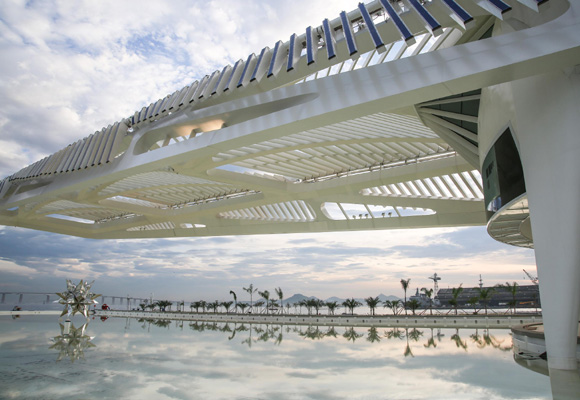
So I modified «ipso facto» my schedule for the week and hasty, I convinced her to let me accompany it on its next trip, she was a little hesitant, I gave her an alternative to the museums who she shuffled up to that time: the Museu do amanhã (tomorrow Museum) in Rio de Janeiro, designed by the architect and engineer Santiago Calatrava (my favourite). She loved the expectation, and we could start the trip to Brazil, «or, Brazil».
In fact, we were part of the 25,400 visitors who discovered the Museum in its first hours of opening to the public on Saturday, December 19. The building is located in the Maravilla port, an old area of the city that needed a new direction, that better excuse than the Games Olympic that will be held shortly to reorder and insert it back to the main city, so they have removed an old Scalextric and have incorporated the Maua square (in front of the Museum).
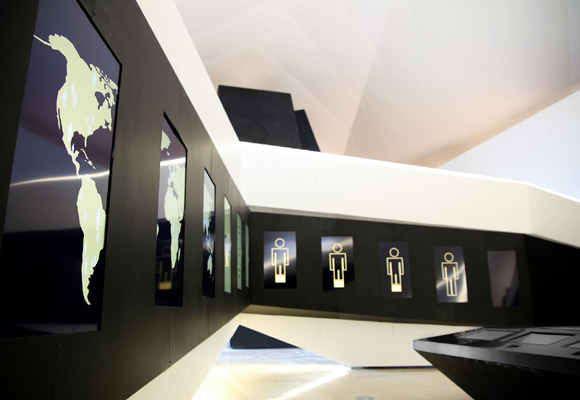
The property occupies all the longitudinal extension of the port, about 338 meters long, this curious position defines its entire structure with a distinctly linear. Calatrava has arranged two huge overhangs, the small, overlooking the Bay, about 65 meters and the largest in 70 meters indicating the square. Inside, the building is divided into two floors with spectacular views over the Bay of Guanabara in the second floor (with ten meters from floor to ceiling), the total height is 18 meters, allowing the vision of another unique building heritage of humanity according to Unesco (the monastery of São Bento).
The construction area is of 34,500 square meters, of which 15,000 belong to the Museum, and, within this, 5,000 to the exposition zones (permanent and temporary) where pose you five questions which, between Carmen (my «new friend» is called thus) and me, answered with confidence. The five questions to reflect on our future are: where do we come from? Who are we? Where are we? Where are we going? And how do we want to live together the next fifty years? (Pure philosophy).
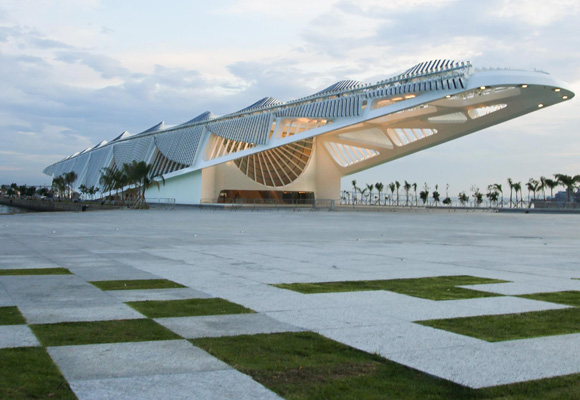
The foundations of the building are under water, so they had divers for its construction: more than 2,500 pillars, 55,000 tons of cement, and the no less significant, 3.810 tons of metal. The Grupsa group was responsible for the supply and placement of the exterior doors, with a weight of 1.7 tons, whose laminated glass (formed by the union of several glasses of equal or different thickness, getting more hardness and safety) 16 millimetres thick are the model AS – 300 Telescopic, which ensures full transparency to situate its mechanisms in the upper frame.
Outside, the landscape architect Burle Marx, has been the responsible to the introducing of the new gardens to the delight of the visitors, combining native species of the Atlantic zone and the forest that border the city of Rio de Janeiro, with 5,500 square meters of green. 26 different species such as the flower of Cuaresma, the purple Lapacho and yellow, the Pitanga and the Palo of Brazil, and, of course, native shrubs of restinga and pictorial palms.
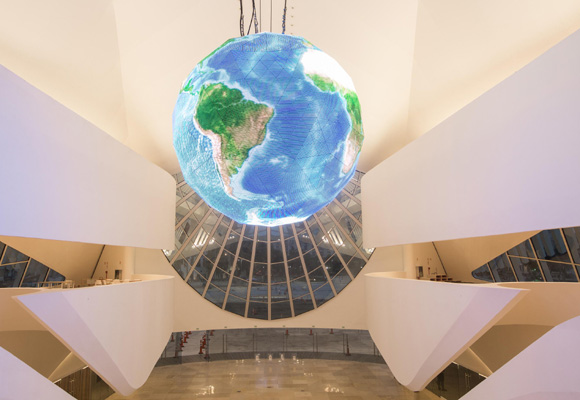
According to the designer, the building is inspired by the vegetation and the Brazilian culture (you use the imagination). «The idea is that the building was the more ethereal possible, almost floating on the sea, like a ship, a bird or a plant» says Santiago, who recorded his ideas in more than 600 watercolours prior to design. «The building is like a body and is directly related to the landscape» said the author, Carmen and I had our differences, she in favour of this concept, I against, you know that for me the buildings are never with space: should differentiate from the rest.
The best, without a doubt, is the efficient use of natural resources which have the Museum of tomorrow, taking advantage of the waters of the Guanabara Bay to supply inside. So, six pumps installed in the basement of the building suck the liquid element in the bottom of the Bay, using it in the heat exchange cooling (cold water absorbs heat from the enclosure, cooling it in a natural way and in a continuous loop). Later, the water used is returned to the Bay, a return to its home (so to speak). We loved the ponds round the building, whose aesthetic function also helps to reduce the ambient temperature up to 2 degrees.
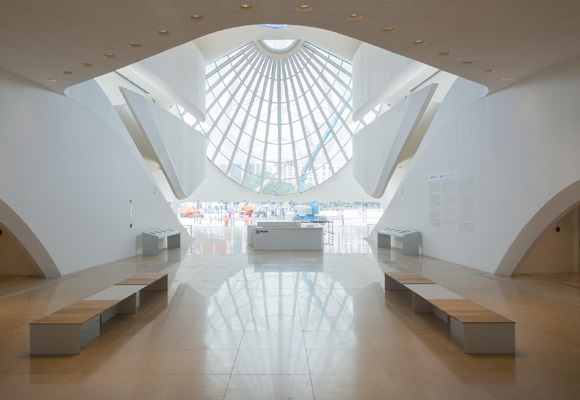
But, really, what did Carmen and I, Rodolfo us embrace with joy, was the contemplation (and corroboration) of the movement of the wings of the building, on the cover. These wings continue perpendicular the way solar, taking full advantage of the impact of its rays and capturing its heat in full. Bravo! (We applaud as children). These photovoltaic panels, arranged in 48 Mobile sets make up the wings, Supplement the 10% of the energy consumption of the building, this, combined with other systems of reduced consumption, makes it easier to achieve the 30% energy saving.
The gutters capture the rainwater, which is stored for reuse, as well as the water of the sanitation of the property and of the air conditioning systems, these waters are used in discharges from the baths, for the washing of the floor and gardens. Noteworthy is the effort to care for the environment during the execution of the work: using recycled materials, low toxicity, high durability and nearby environment, the wood was certified by FSC (entity that guarantees the origin of the wood and the good treatment with the environment during its production), even got to wash the wheels of the trucks with reused water (all an example).
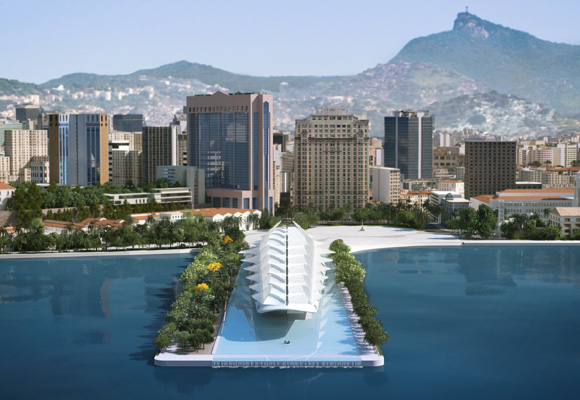
However, the developers are confident that they will have soon the certificate LEED (Leadership in Energy and Environmental Design), the global reference of the certification for sustainable practices. The Museum of tomorrow is a joint project of the city of Rio de Janeiro and the Roberto Marinho Foundation, which has sponsored the Bank of Santander and BG Brazil. An initiative of the Bank of Santander has been known as “reduce and offset CO2”, which estimated emissions and is offset by the purchase of carbon credits from one of the projects of the programme, all over the planet.
A trip has never been so pleasant, not only for the architecture, the country and its people, also was it by the company. Carmen showed me that people are more when the more we want to be, we are better the more we strive to be so, and, finally, taught me that age is circumstantial when you will to live every moment of your life span. To her, I said «see you soon», to you, of course, I say the usual. Bye bye.
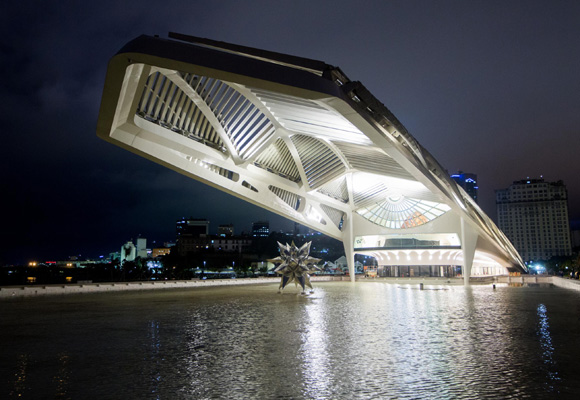
Disclosure: The characters that appear in this article, their different personalities and their relationships with each other and with the environment are part of a fiction. The author is not responsible for the views expressed in the article and has no business relationship with any of the companies listed on it.
